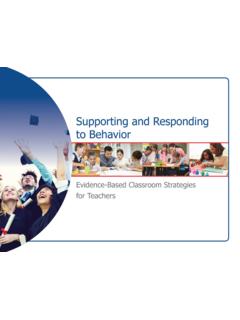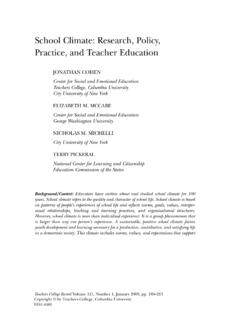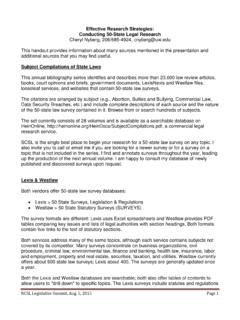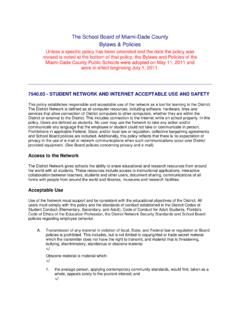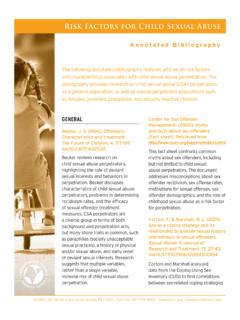Transcription of STUDENT BEHAVIORAL EXPECTATIONS - pbis.org
1 NAPA VALLEY UNIFIED SCHOOL DISTRICT. STUDENT BEHAVIORAL EXPECTATIONS . Napa Valley Unified School District SUPERINTENDENT. Patrick Sweeney, Ed. D. SCHOOL BOARD MEMBERS. Jacqueline Chilton Robert (Robb) Felder Jose Hurtado Tom Kensok Alan Murray Francis Ortiz-Ch vez Joe Schunk California Education Code Section 48980 and 48915, states that school districts must notify the parent or guardians of all pupils registered in schools of the district's rules pertaining to STUDENT discipline. California Education Code Section authorizes each school to develop discipline rules and procedures. Schools shall provide this information in writing to continuing pupils at the beginning of each school year and to any other pupils, and their parents or guardians at the time of their enrollment.
2 NAPA VALLEY UNIFIED SCHOOL DISTRICT. STUDENT BEHAVIORAL EXPECTATIONS Every STUDENT , pre-school through adult, has the right to be educated in a safe, respectful and welcoming environment. Every educator has the right to teach in an atmosphere free from disruption and obstacles that impede learning. The school environment should be characterized by positive interpersonal relationships among students and between students and staff. To that end, the district has adopted and implemented a school wide Positive Behavior Intervention and Support (PBIS) program. PBIS is based on research that indicates that the most effective discipline systems use proactive strategies designed to prevent discipline problems.
3 Before consequences are given, students must first be supported in learning the skills necessary to enhance a positive school climate and avoid negative behavior. This research also shows that there is a strong link between a positive school climate and academic success for all students when students clearly understand BEHAVIORAL EXPECTATIONS . Each school will develop and annually revise a PBIS Plan that will include: teaching positive school rules; implementing a social emotional skills development and enhancement program; positively reinforcing appropriate STUDENT behavior; using effective classroom management; providing early intervention and support strategies for misconduct; and appropriate use of logical and meaningful consequences including the use of restorative practices.
4 In conjunction with a site's PBIS Plan the NVUSD STUDENT BEHAVIORAL EXPECTATIONS provide additional guidance to students, parent / caregivers, teachers, and administrators regarding appropriate behavior. It is only with the understanding, collaboration and cooperation of everyone who has a stake in the education of our youth that we can succeed in creating learning environments that are conducive to optimum academic achievement for all students. STUDENT RESPONSIBILITIES. Students are expected to learn and model NVUSD STUDENT BEHAVIORAL EXPECTATIONS , follow all school and classroom rules and demonstrate appropriate social skills when interacting with both adults and peers. When BEHAVIORAL EXPECTATIONS are not met, the STUDENT is expected to work to improve behavior.
5 1. BE SAFE. I am responsible, like everyone else, for maintaining safety at school. I engage in activities that are safe and report any known safety hazards I help maintain a clean and safe campus that is free of graffiti, weapons, and drugs. I report any bullying or harassment. I avoid conflicts and physical or verbal violence. 2. BE RESPECTFUL. I treat others the way I want to be treated. I respect laws, rules, and school authority. I treat people fairly and respect their rights. I respect private and public property. I am honest with myself and others. I avoid spreading rumors or gossip. I respect each person's right to be different and I look for the good in others. 3. BE RESPONSIBLE. I take responsibility for my actions.
6 I choose how I respond to others. I return what I borrow to the same person, in the same condition. I give my best in everything I do. I come to school regularly and on time, ready to learn. I help to create a positive school environment. NVUSD STUDENT BEHAVIORAL EXPECTATIONS 2 Revised: 4/98, 3/00, 6/01, 6/03, 8/06, 3/11. PARENT/CAREGIVER RESPONSIBILITIES. Parents/Caregivers will take an active role in supporting the school's efforts to maintain a welcoming school climate. 1. Support the implementation of the school's PBIS Plan. 2. Be familiar with and review the NVUSD STUDENT BEHAVIORAL EXPECTATIONS and school rules with their children. 3. Reinforce positive behavior and acknowledge their children for demonstrating appropriate conduct.
7 4. If misconduct escalates, parent/caregivers will cooperate with the school as a collaborative partner to address STUDENT 's needs. 5. Send the STUDENT to school prepared for work--with books, pencil, homework, and appropriate dress. 6. Insure that the STUDENT attends school regularly and is on time. 7. Provide a home environment that encourages respect for the school and the learning process; provide a healthy environment with adequate nutrition, and rest. 8. Take corrective action when requested by the teacher or principal. TEACHER RESPONSIBILITIES. Each teacher has a fundamental role in supporting a positive classroom and school. This includes utilizing effective classroom management strategies to create an environment conducive to learning and prevent misconduct.
8 The teacher is responsible for: 1. Defining, teaching, reviewing and modeling NVUSD STUDENT BEHAVIORAL EXPECTATIONS and school rules. 2. Acknowledging and reinforcing appropriate STUDENT behavior. 3. Providing corrective feedback and re-teaching the BEHAVIORAL skill when misconduct occurs. 4. Working with families in partnership to reinforce appropriate behavior (meeting, mailing correspondence, utilizing parent center as appropriate, etc.). 5. Teaching the district-approved and evidence based social emotional curriculum in elementary and middle schools ( Second Step, LifeSkills Training, Steps to Respect). 6. Following the behavior support plan for students with disabilities available to all staff working with identified students.
9 7. Utilizing data in collaboration with administration and support personnel to monitor misconduct ( SWIS). 8. Reporting the behavior to the school administrator or person responsible for discipline at the school-site for a STUDENT who engages in ongoing misconduct, despite appropriate interventions 9. Assuming responsibility for all students of the school, not just those in individual classrooms. 10. In the event a STUDENT is placed in Classroom Suspension or In School Suspension, the teacher MUST provide the STUDENT with sufficient and relevant classroom work in order to keep the STUDENT engaged in learning. PRINCIPAL RESPONSIBILITIES. Each school administrator is a role model and a leader. School administrators, in collaboration with instructional staff and community support, are responsible for establishing a caring school climate and safe environment by: 1.
10 Ensuring that NVUSD STUDENT BEHAVIORAL EXPECTATIONS and school rules will be taught, enforced, advocated, communicated and modeled to students, parents/caregivers, staff and community. 2. Annually developing and implementing a PBIS Plan consistent with the Positive School Climate Board Policy (BP 5137). 3. Ensuring that ongoing accurate data are inputted into the district AERIES STUDENT data base for all students. 4. Utilizing methods for recording, collecting and analyzing behavior/discipline information to monitor and evaluate data for ongoing decision making from the individual STUDENT through the school-wide STUDENT population. 5. Providing necessary training and support for staff and parents/caregivers in maintaining an environment conducive to learning.
